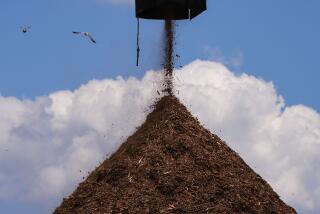Paper Work
- Share via
When Melissa Smedley and Jeff Lindenthal were planning their wedding in 1990, Lindenthal wanted to make the invitations by hand.
Having just completed a master’s thesis on a paper mill that converted to a recycling operation, he’d learned a lot about paper-making techniques and wanted to give it a try. “I was a little skeptical,” recalls Smedley, an artist, “but I went along with it.”
Combining such ingredients as a ground-up linen skirt, cotton rags and some corn husks, Lindenthal produced a fine paper that was printed on a letter press. “The invitations were beautiful--really elegant,” Smedley says. Two years later, when the couple had moved from Boston to San Diego and found themselves getting dismaying amounts of junk mail, they put two and two together and launched an offbeat business they named Found Stuff PaperWorks.
The firm has slowly but steadily expanded, and their discovery that paper doesn’t have to be made out of trees has cast them in the forefront of a new movement in the roller-coaster history of paper in America: tree-free. Experimenting with a smorgasbord of alternative fiber sources, they make elegant note cards and stationery from garlic skins, hemp, American corn, old rags, organic cotton and other fibers.
“I call their operation a micro-mill,” says Gerard Gleason of San Francisco’s Conservatree Paper Co., an information clearinghouse for recycled paper. “Like a microbrewery, they are putting out these little hand-crafted products. . . . They are producing great paper which competes with prestige lines like Crane’s bond.”
Tree-free is a tiny market now, Gleason says, with only an estimated half a dozen niche companies. But he views it as an important long-range issue, as consumers become more sophisticated about what they want in paper.
In a two-story complex in downtown San Diego, Smedley and Lindenthal occupy three suites--an office, a warehouse / shipping space and a paper-making studio. Like gourmet chefs, they whip up batches of pulp, working with a 300-gallon vat, bags of fiber, a pulping beater and a hydraulic manual press.
One of their most popular items is Grow-A-Note paper, which is implanted with seeds (wildflowers, tomatoes, peppers or forget-me-nots) in the pulp stage and packaged with instructions on how to plant the note after you read it. “It’s a gimmick, but it’s fun and it makes the letter somewhat more of a gift,” Smedley says.
For the last two years the two have been focusing on organic cotton paper. They buy textile waste from clothing manufacturers and sell it back as finished paper for hang tags, letterhead and business cards. And they’re the sole manufacturers of bulk paper made from FoxFibre, organic cottons that grow in rich shades of green and brown, requiring neither dyes nor bleaches. Their wholesale catalog of paper, stationery, sketch books and journals now lists more than 30 items that they sell to retailers nationwide, ranging from the Smithsonian Museum shop to Vermont’s Seventh Generation.
“Our progress hasn’t been off the charts, but laborious, and educating customers as we go,” Smedley says. “People like the look and feel of this paper.”
The family business (Jeff’s sister Jodi Lindenthal is the third owner and accountant) changed its name this year to Green Field Paper Co. as the parent company of Found Stuff.
Although “paper” has a trivial, flimsy sound, its role in our lives has grown into an incendiary environmental issue, Gleason says. One Conservatree “factoid” sums it up: Every ton of recycled paper saves 17 trees, 7,000 gallons of water and 3 cubic yards of landfill.
Such statistics make it imperative to keep talking about new ways to produce paper, says Norman Dean, president of Green Seal, a Washington, D.C.-based organization that helps businesses and consumers find products that are the least damaging to the environment.
Dean led an industry panel discussion of paper options at Eco Expo in Los Angeles earlier this month. The good news, he told his audience, is that we are getting better at producing paper with less pollution and are recycling more paper than ever before-- an estimated 40% of all paper. The bad news? Americans are using paper at an accelerating rate. U.S. consumers use an estimated 700 pounds per person every year.
The fledgling tree-free movement holds promise for the paper industry, says Brian West of ReThink Paper, a research group in San Francisco. But, despite modest steps among the giant companies, he says the “industry needs to move in this direction.” Indeed, Fox River Paper, a mill in Wisconsin, has introduced a new Tree Free line using tropical grasses, the first major U.S. paper producer to do this.
More to Read
Inside the business of entertainment
The Wide Shot brings you news, analysis and insights on everything from streaming wars to production — and what it all means for the future.
You may occasionally receive promotional content from the Los Angeles Times.










